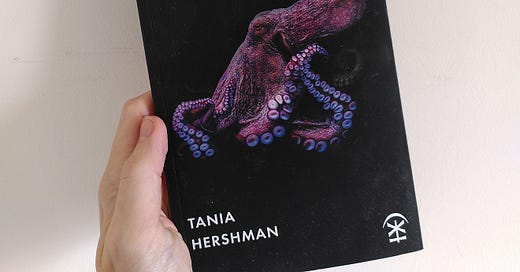"Reckless extravagance"
Tidepool Orgies -- Octopus Organs -- Mega-Minifesto -- Cats in Lost Cities
Part one of a mega February-to-May catch-up.
Saucy Seaside Postcards
I’ve published a large number of poems over the last decade which have never been collected into one single-author volume. Some are part of Sidekick anthologies and very happily nested there, while others are intended for future books that may or may not materialise. For now, I’m experimenting with making some of them into digital postcards and adding them to the jukebox/gashapon machine on my website. I’m also trying to line up their publication with relevant dates. So ‘Pangolin Documentary’, for example, went online on World Pangolin Day 2023 (18 February) while the below poem (originally published in Aquanauts) was given the postcard treatment in time for John Steinbeck’s birthday:
Supple Companions
I’ve recently reviewed Tania Hershmann’s debut collection, Still Life With Octopus. Here’s an extract:
Still Life With Octopus begins and ends with poems titled ‘Arrival’, and is full of things arriving or becoming, or suggesting they might like to be more deeply involved with one another somehow — the theme of tying, sewing, stitching recurs as well […] and the octopus as symbol of fleshy entanglement is never far away. Body parts — chiefly, internal organs — and their relationship to one another also come to the fore more than once …
“Awe is cheap.”
I’m trying to find more time to read and write about poems and poetry books (other than my own!), in part because I continue to be alarmed by the lack of a vibrant critical culture around poetry. Promotionism is the default mode everywhere I look; everything is great. Everything is exciting and everyone is chuffed to be involved, or chosen, or featured. Everything must be read, or seen, or attended. These are all, quite deliberately, conversational dead ends. The problem is not (as is sometimes expressed) that people need to dislike or criticise more; it’s that there is a total lack of faith that attention can be generated and maintained by straightforwardly describing what any particular piece of work is and does, or by investing time in responding engagedly to it. The currency is awe, faux-awe and pompous pronouncements as to something or someone’s importance.
So I’ve been writing pieces which advocate for an alternative way forward. The longest and fullest of these so far is called ‘Search More Widely, Look More Closely: A minifesto on reaching one another’, using the same title as the podcast I’ve recently started (though I may change the title of that to just ‘The Stray Bulletin Podcast’). It contains some analysis and some suggestions, linking our modern propensity for promotionism to the lack of scruples among those in power, and to the present-day loneliness epidemic. My chief recommendation is really very simple: that we stop crowding around the big, glitzy stuff and start paying thought and attention to all that lies neglected.
“Tell them I was brave.”
I played through Stray in March — it’s a single-player, story-driven adventure game lasting about six hours if you take it at a leisurely pace. For many players, the draw is that you play as a cat. A cat who acquires a tiny backpack and tiny robot companion, no less, and who can stretch, mew, claw at rugs, scratch at doors, purr and rub up against people’s legs. This is all very agreeable, but I was more taken with the fact that the world design is heavily inspired by Kowloon Walled City, a small region of Hong Kong which was demolished 30 years ago. There’s a seven-acre park where it used to be, with a brass model of the city at its entrance. I visited there in 2015, wishing I had arrived a quarter of a century earlier — since the city was famous for, among other things, the fact that sunlight never reached its lower levels. It was akin to a man-made, artificially lit cave system or subterranean electric labyrinth. BlueTwelve Studio, the developers behind Stray, have done an excellent job of building on the atmosphere suggested by old photographs of KWC, ramping up the neon without omitting the dampness.

It’s an easy game with a few light puzzles, some enjoyable chase sequences and a large cast of charming but mostly undeveloped robot characters. You can access a number of the homes of these characters, which are lovingly furnished with junk, books, plants, pictures, knick-knacks and worn materials. Some of the most fun I had in Stray was just nosing around, inspecting the features of a room and trying to imagine how I could reproduce it, come the day when I own my own place.






